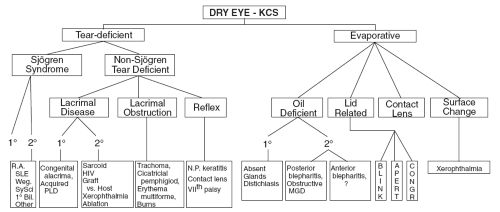Keratoconjunctivitis Sicca: Introduction
Michael A. Lemp
Keratoconjunctivitis sicca (KCS) is a rubric to describe a variety of pathologic conditions characterized by abnormalities of the preocular tear film resulting in ocular surface damage (1). Our knowledge base concerning these disorders has grown substantially in the last three decades and has led to the recognition that the pathogenetic mechanisms operative in KCS are complex and interrelated. Far from being simply a matter of insufficient lacrimal fluid, it is now known that many factors involving the lacrimal glands, lids, ocular surface, lacrimal drainage ducts, medications, contact lens use, and environment affect the signs and symptoms. Various epithets have been used to characterize this group of conditions including dry eye, dry eye syndrome, blepharitis, meibomian gland dysfunction, and contact lens-induced dry eye. Some of these reflect an inclusive description, whereas others describe subtypes of KCS.
Although the presenting symptoms and signs of KCS are similar, an as yet unanswered question is whether there is a common underlying initial abnormality leading to a variety of changes in the morphology and function of the ocular surface and adnexal structures.
The preocular tear film has been previously thought of as a three-layered structure consisting of an innermost mucin layer, an intermediate aqueous layer, and an outer lipid layer (2). Recent research has elucidated this structure; there are two mucin-secreting systems, one produced by the corneal and conjunctival epithelial cells forming an outer glycocalyx cell-associated layer (MUC1) (3). In addition, a more highly hydrated form of mucin (MUC5AC), produced by the goblet cells of the conjunctiva, constitutes a loose mucin blanket dispersed within the aqueous layer (4). Both serve to protect the ocular surface. The aqueous layer produced primarily by the main and accessory lacrimal glands forms the bulk of the tear film. Its secretion is driven by neural stimulation and the previous distinction between “basal” and “stimulated” tears has largely been abandoned (5); as much as 10% of the aqueous tear component may come from transconjunctival flow. The outermost lipid layer is the product of the secretion of the meibomian glands of the eyelids. These lipids form a bilayer structure that retards evaporative tear loss and stabilizes the film (6).
The tear film serves a number of important functions in maintaining a normal ocular surface in health and in the repair of the surface in response to injury. The tear film is the anterior refracting surface of the eye; breakdown in this principal optical element will degrade the visual image presented to the retina, compromising clear vision. In addition, the tear film is a source of essential nutrients and oxygen for the cornea and conjunctiva.
The ocular surface is supplied with dense sensory innervation. This neural array plays a central role in the maintenance of a healthy ocular surface. The lacrimal glands, meibomian glands of the eyelid, lacrimal outflow channels, and the ocular surface form an integrated functional unit that tightly regulates the turnover of cells of the ocular surface (7). Through the production of a large number of proteins (growth factors, cytokines, and chemokines), the lacrimal glands direct cellular activities at the ocular surface designed to maintain the regular formation, movement, and exfoliation of ocular surface epithelial cells and their recruitment in repair of the surface; the tear film is the conduit for this regulation. Sensory input from the surface informs the glandular structures directing the production of these various factors from the lacrimal glands, the meibomian glands of the lids, and the mucin-producing cells of the ocular surface. The tear film also provides hydration to corneal and conjunctival epithelium and lubrication to control the frictional forces between the upper lid and the ocular surface. Disruption in this exquisitely coordinated system can lead to a cascade of events resulting in symptoms ranging from irritation to incapacitating pain and signs of surface inflammation to breakdown of the ocular surface.
The National Eye Institute/Industry Workshop Report on Clinical Trials in Dry presented a classification of KCS eye in 1995 (Fig. 26-1). This schema identifies two main divisions of KCS: aqueous tear deficiency and evaporative tear deficiency. These categories describe two major pathogenetic mechanisms operative in ocular surface disease
associated with dry eye. Although these are discrete mechanisms, they frequently coexist (and share common pathologic features); for example, over 60% of patients with Sjögren syndrome (SS)-associated KCS have both forms of dry eye (8). Another intriguing aspect of KCS is the relationship with SS. Many of the patients with more severe KCS have evidence of SS. It is not known whether patients with KCS but without SS represent a distinct pathologic category or rather a milder form of a similar immunologic abnormality (9).
associated with dry eye. Although these are discrete mechanisms, they frequently coexist (and share common pathologic features); for example, over 60% of patients with Sjögren syndrome (SS)-associated KCS have both forms of dry eye (8). Another intriguing aspect of KCS is the relationship with SS. Many of the patients with more severe KCS have evidence of SS. It is not known whether patients with KCS but without SS represent a distinct pathologic category or rather a milder form of a similar immunologic abnormality (9).
 FIGURE 26-1. The National Eye Institute (NEI)/Industry Workshop on Clinical Trials in Dry Eye Classification |
Many factors are now known to contribute to the clinical picture of KCS. These factors include qualitative changes in tear composition (10), increased evaporative tear loss (11), immunologic abnormalities (12), age-related decreases in glandular function (13), hormonal dysfunction (14), changes in mucin production (15), inflammation of the glands and ocular surface (7), changes in epithelial cell turnover (16), abnormalities of tear flow, and decreased sensory function (7). Most of these factors are interactive; which of these are primary in the causation of KCS remains a subject of speculation.
Stay updated, free articles. Join our Telegram channel

Full access? Get Clinical Tree


